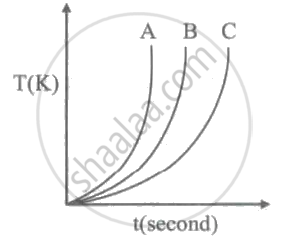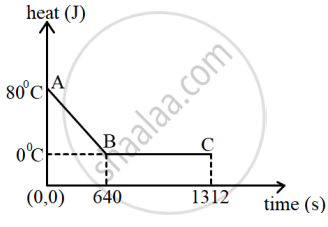Advertisements
Advertisements
प्रश्न
The difference between the two molar specific heats of gas is 9000 J/kg K. If the ratio of the two specific heats is 1.5, calculate the two molar specific heats.
उत्तर
Given,
Cp - Cv = 9000 J/kg K
`"C"_"p"/"C"_"v" = 1.5`
Cv = ?
Cp = ?
`"C"_"p"/"C"_"v" = 1.5`
`"C"_"p" = 1.5 " C"_"v"`
`"C"_"p" - "C"_"v" = 9000`
`1.5 " C"_"v" - "C"_"v" = 9000`
`0.5 " C"_"v" = 9000`
`therefore "C"_"v" = 9000/0.5`
= 18000 J/kg k
`therefore "C"_"p" = 9000 + "C"_"v"`
= 9000 + 18000
= 27000 J/kg k
∴ Two molar specific heats ore 18000 J/kg k and 27000 J/kg k.
APPEARS IN
संबंधित प्रश्न
State two factors upon which the heat absorbed by a body depends
A solid metal weighing 150 g melts at its melting point of 800 °C by providing heat at the rate of 100 W. The time taken for it to completely melt at the same temperature is 4 min. What is the specific latent heat of fusion of the metal?
Two metallic blocks P and Q of masses in ratio 2: 1 are given the same amount of heat. If their temperature rise by the same amount, compare their specific heat capacities.
A heater of power P watt raises the temperature of m kg of a liquid by Δt K in time t s. Express
the specific heat capacity of liquid in terms of above data.
Explain the term boiling ?
What is meant by global warming?
What is the unit of heat capacity in CGS system?
What is heat? What is the S. I. unit of heat?
Write the approximate values of the specific latent heat of fusion of ice.
The farmers fill their fields with water in winter. Give reason.
Explain, why does a wise farmer water his fields, if forecast is forst?
Specific heat capacity of substance A is 3.8 J g-1 K-1whereas the specific heat capacity of substance B is 0.4 J g-1 K-1. Which of the two is a good conductor of heat? How is one led to this conclusion?
Give two reasons as to why copper is preferred over other metals for making calorimeters.
1 kg of water freezes to form ice at 0°C. What amount of heat is withdrawn?
A piece of ice is heated at a constant rate. The variation of temperature with heat input is shown in the graph below:

(i) What are represented by AB and CD?
(ii) What conclusion can you draw regarding the 110°c nature of ice from the above graph?
The temperature of a lead piece of mass 400 g rises from 20°C to 50°C when 1560 J of heat is supplied to it. Calculate Specific heat capacity of lead.
Calculate the amount of heat released when 5.0 g of water at 20°C is changed into ice at 0°C.
(Specific heat capacity of water = 4.2 J/g°C
Specific latent heat of fusion of ice = 336 J/g)
State factors on which the amount of heat radiated by a body depends.
Write the name.
The amount of heat absorbed at constant temperature by unit mass of a liquid to convert into gaseous phase.
Consider the statement given below and choose the correct option.
Assertion: Radiation is a form of heat transfer which takes place only in vacuum.
Reason: The thermal energy is transferred from one part of a substance to another part without the actual movement of the atoms or molecules.
What is specific heat capacity?
Which of the following substances (A, B and C) has the highest specific beat?

Two uniform brass rods A and B of length land 2l and radii 2r and r respectively are heated to the same temperature. The ratio of the increase in the volume ofB to that of A is ____________.
At same temperature and pressure of an ideal gas, ____________.
The ratio of the specific heats `c_"p"/c_"v"=gamma` in terms of degrees of freedom 'n' is given by ______.
The diagram below shows a cooling curve for 200 g of water. The heat is extracted at the rate of 100 Js-1. Answer the questions that follow:

- Calculate specific heat capacity of water.
- Heat released in the region BC.
Two metals A and B have specific heat capacities in the ratio 2:3. If they are supplied same amount of heat then
If the mass ratio of metal A and metal B is 3:5 then calculate the ratio in which their temperatures rise.
Why is water used as a coolant in radiators of a car?
Find the odd one out:
